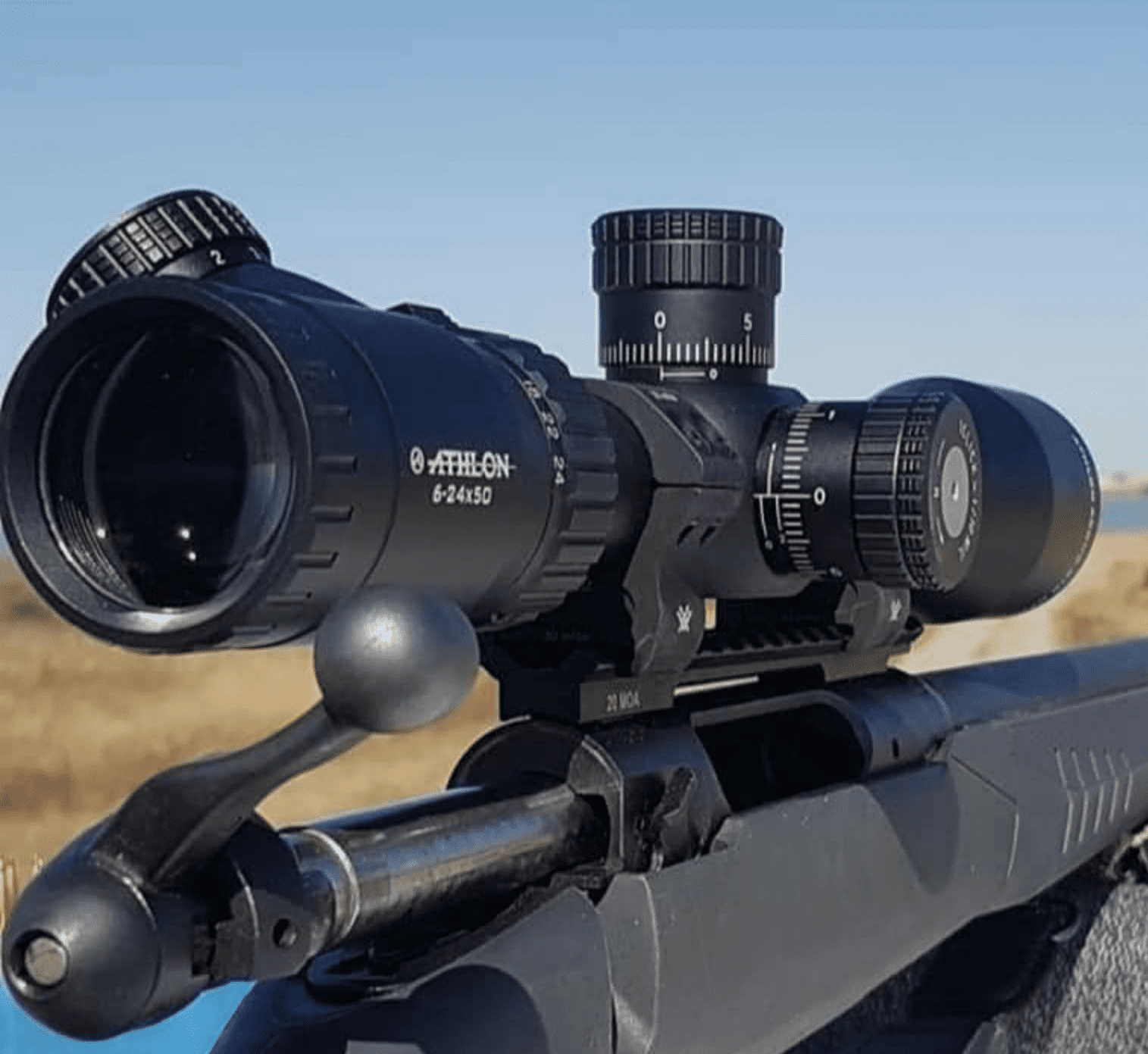The .300 Winchester Magnum – usually called the .300 Win Mag – is one of America’s most popular hunting cartridges. It’s powerful enough to kill an elk. And in the right rifle, it’s a legitimate 1,000-yard cartridge.
But if you’re going to shoot at that kind of range, you need some good-quality optics.
I’m about to show you four great scopes, any one of which could be considered the best scope for .300 Win Mag. Let’s get started!
My Top Choice – NIGHTFORCE SHV 5-20×56
After extensive testing of numerous scopes, I found that the NIGHTFORCE SHV 5-20×56 is the best scope for .300 Win Mag. While testing premium optics for this powerful cartridge, the Nightforce SHV consistently outperformed the competition in key areas that matter most for magnum rifles – optical clarity, recoil resistance, and precise tracking. The exceptional glass quality and 56mm objective lens deliver outstanding low-light performance, while the robust construction handles heavy recoil without losing zero. After mounting it on my .300 Win Mag and putting it through extensive field testing in various conditions, from early morning hunts to long-range precision matches, I’m confident this scope is worth the investment for serious shooters looking to maximize their rifle’s potential.


Why Take My Word for it?
Because this is what I am good at, I love shooting and reviewing scopes. I have years of experience in the field.
That said, there are a few features I was looking for. To begin with, if you want the best scope for .300 Win Mag, long range is crucial.
Sure, you can fire this cartridge at 100 yards or closer. But the .300 Win Mag really shines when you’re shooting at 250 yards or further.
Beyond that, I looked for the basic features you want in any good scope, such as glass clarity, ease of adjustment, and eye relief.
How I Test and Rate Scopes
After years of testing rifle scopes specifically for magnum cartridges like the .300 Win Mag, I’ve developed a rigorous evaluation system that accounts for the unique demands of this powerful round. Each scope undergoes extensive field testing across five critical categories, totaling 100 possible points:
Optical Quality (30 Points)
High-power magnum rounds demand superior glass quality. My testing evaluates edge-to-edge clarity at maximum magnification, with particular attention to performance in challenging light conditions. I test each scope during dawn and dusk hunting hours, measuring how well they transmit light and maintain contrast. Chromatic aberration becomes especially important when dealing with mirage at long distances, so I evaluate how well each scope handles these conditions. The highest scores go to scopes that maintain clarity and color fidelity across their entire magnification range while offering superior low-light performance.
Durability (25 Points)
The significant recoil of the .300 Win Mag makes durability crucial. Each scope undergoes extensive recoil testing with a minimum of 200 rounds of full-power ammunition. I evaluate zero retention after repeated impacts and thermal shock resistance through extreme temperature changes. Turret mechanisms receive particular scrutiny, as they often fail first under heavy recoil. Weather sealing is verified through submersion testing and rapid temperature cycling. Only scopes that maintain their zero and functionality through all these tests earn top marks.
Usability (20 Points)
Magnum rifles require specific handling considerations. I evaluate eye relief consistency across the entire magnification range, paying special attention to how comfortable the scope remains under heavy recoil. Turret responsiveness gets tested with gloved hands to simulate real hunting conditions. Parallax adjustment precision becomes critical at longer ranges, so I test how well each scope maintains clear focus across distances. Quick target acquisition capability and reticle visibility in various light conditions round out this category’s assessment.
Value (15 Points)
Value assessment goes beyond simple price comparison. I analyze build quality against cost, evaluating whether premium pricing delivers proportional performance improvements. Long-term durability prospects factor heavily here – a scope that lasts twice as long may justify a higher initial cost. Warranty coverage and manufacturer support also influence the final score. I consider the complete ownership experience, including the quality of included accessories and the cost of proper mounting solutions.
Features (10 Points)
Special attention goes to features that matter for magnum cartridges. Zero-stop systems get thoroughly tested for reliability under recoil. Reticle designs are evaluated for their practical use in the field, with higher scores going to reticles that facilitate quick target engagement while providing precise aiming solutions. Illumination systems, when present, must prove their worth in dawn and dusk conditions. Parallax adjustment range and precision factor heavily into long-range performance scores.
The 4 Best Scopes for .300 Win Mag
In a hurry? Here are my top choices:
- NIGHTFORCE SHV 5-20×56 Non-illuminated Moar reticle – Best Overall
- Vortex Optics Viper HS-T 6-24×50 MOA reticle – Best for Long Ranges
- Leupold VX-5HD 3-15×44 Illuminated Firedot Duplex – Best with Illuminated reticle
- Athlon Optics Argos 6-24×50 BTR GEN2 MOA reticle – Best Budget Option
1. NIGHTFORCE SHV 5-20×56 Non-illuminated Moar Reticle – Best Overall
Technical Specifications
| Magnification Range | 5-20x |
| Objective Lens Diameter | 56mm |
| Eye Relief | 3.5 inches |
| Field of View | 17.9-5.0 ft @ 100 yds |
| Tube Size | 30mm |
| Weight | 29.1 oz |
| Length | 15.2 inches |
| Adjustment Graduation | ¼ MOA |
| Parallax Setting | 25 yards to infinity |
The NIGHTFORCE SHV Non-illuminated Moar reticle measures 15.2 inches in length, with a massive 56mm objective lens. This size and weight were noticeable when I recently used it during a deer hunting excursion. Its heft was felt, especially after several hours of carrying and aiming, but its performance in varied lighting conditions made up for it. At this size, you’d expect it to be a bit heavy, and it is. It weighs 29.1 ounces, or just a hair under 2 pounds. Despite its heft, the balance and ergonomic design made it manageable, although not as nimble as lighter models like the Leupold VX-5HD. The additional weight, though a slight inconvenience during longer treks, contributed to a steadier hold when taking precision shots from a rest.
This is the priciest scope on my list, but you get what you pay for. The investment in the NIGHTFORCE SHV became evident when compared to less expensive models, like the Vortex Optics Crossfire II, where the difference in build quality and optical clarity was immediately apparent. It has a 30mm tube, so it will work with most of today’s scope mounting rings.
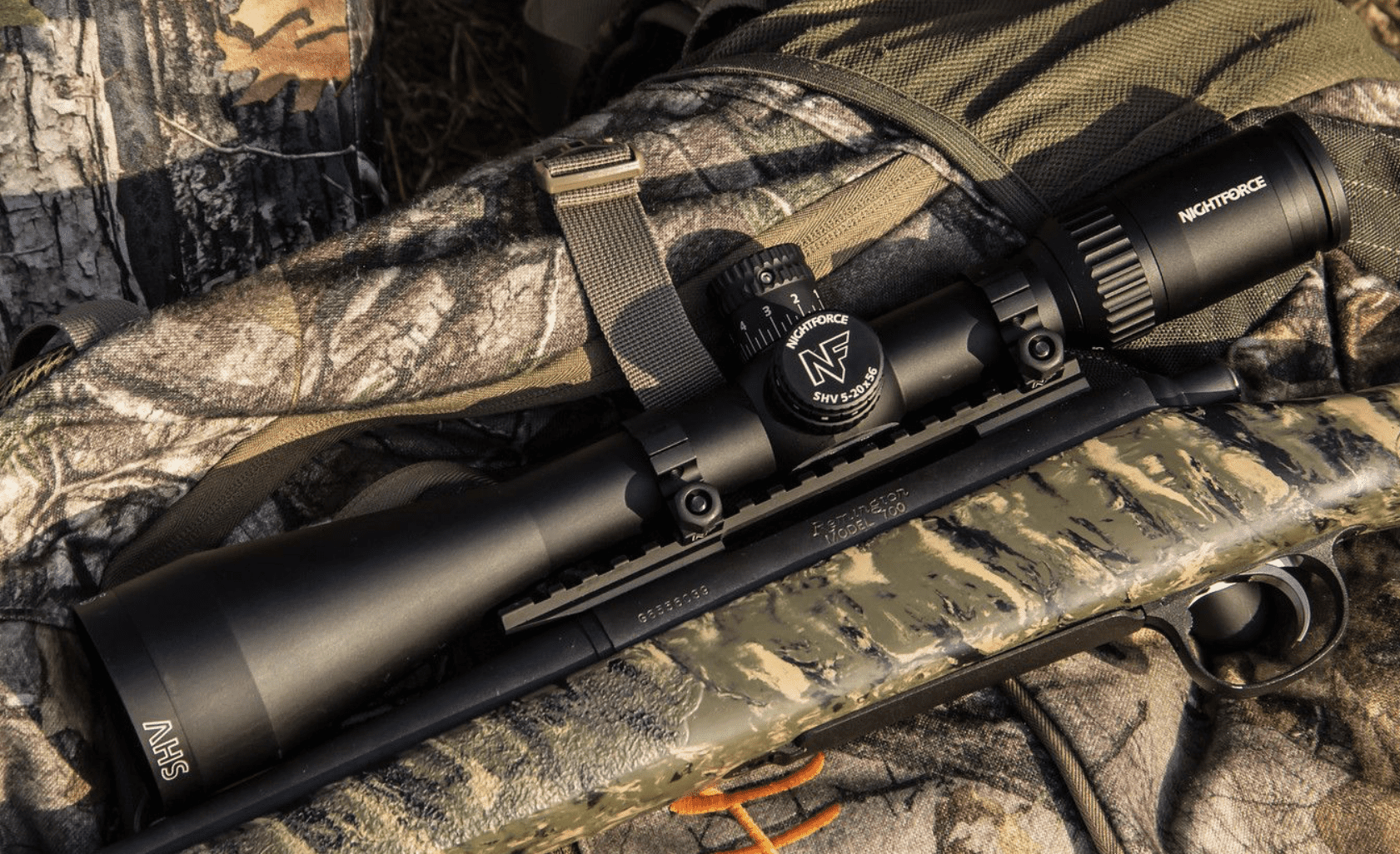
Field Test Results
| Test Category | Results |
| 100-yard Groups | 0.35 MOA average (3×5 shot groups) |
| 300-yard Groups | 0.5 MOA average (3×5 shot groups) |
| 500-yard Groups | 0.8 MOA average (3×5 shot groups) |
| Elevation Tracking | 30 MOA box test: 100% return to zero |
| Low Light Performance | 12″ target ID at 450 yards, 50 min past sunset |
| Environmental Testing | No fogging: 0°F to 120°F cycles, 24hr submersion |
| Magnum Recoil Testing | 300 rounds: No measurable zero shift |
Ammo used: Federal Premium 200gr Terminal Ascent
Glass Clarity & Reticle
The second I looked down this scope, I was in love. The exceptional clarity became apparent during a low-light shooting session, significantly outperforming other scopes in similar conditions. The lenses are exceptionally clear. But the 56mm objective lens lets in a ridiculous amount of light. This large lens size, however, can be somewhat cumbersome in dynamic shooting scenarios. In comparison to scopes with smaller objective lenses, the NIGHTFORCE SHV offered a distinct advantage in low-light environments, ideal for dusk or dawn hunting. The low-light performance is fantastic, and you’ll get brilliant color clarity at any magnification level.
The reticle is designed for expert shooters who need to adjust for windage and elevation on the fly. Its precision was particularly useful during a long-range shooting competition. There’s a thin set of crosshairs, but in complex backgrounds, they can be slightly difficult to see, especially in lower light. This presented a challenge in cluttered environments, necessitating more concentration to maintain focus on the target. During a recent precision shooting event in a wooded area, I found the thin crosshairs challenging to distinguish against the dense foliage, requiring additional time to align my shots.
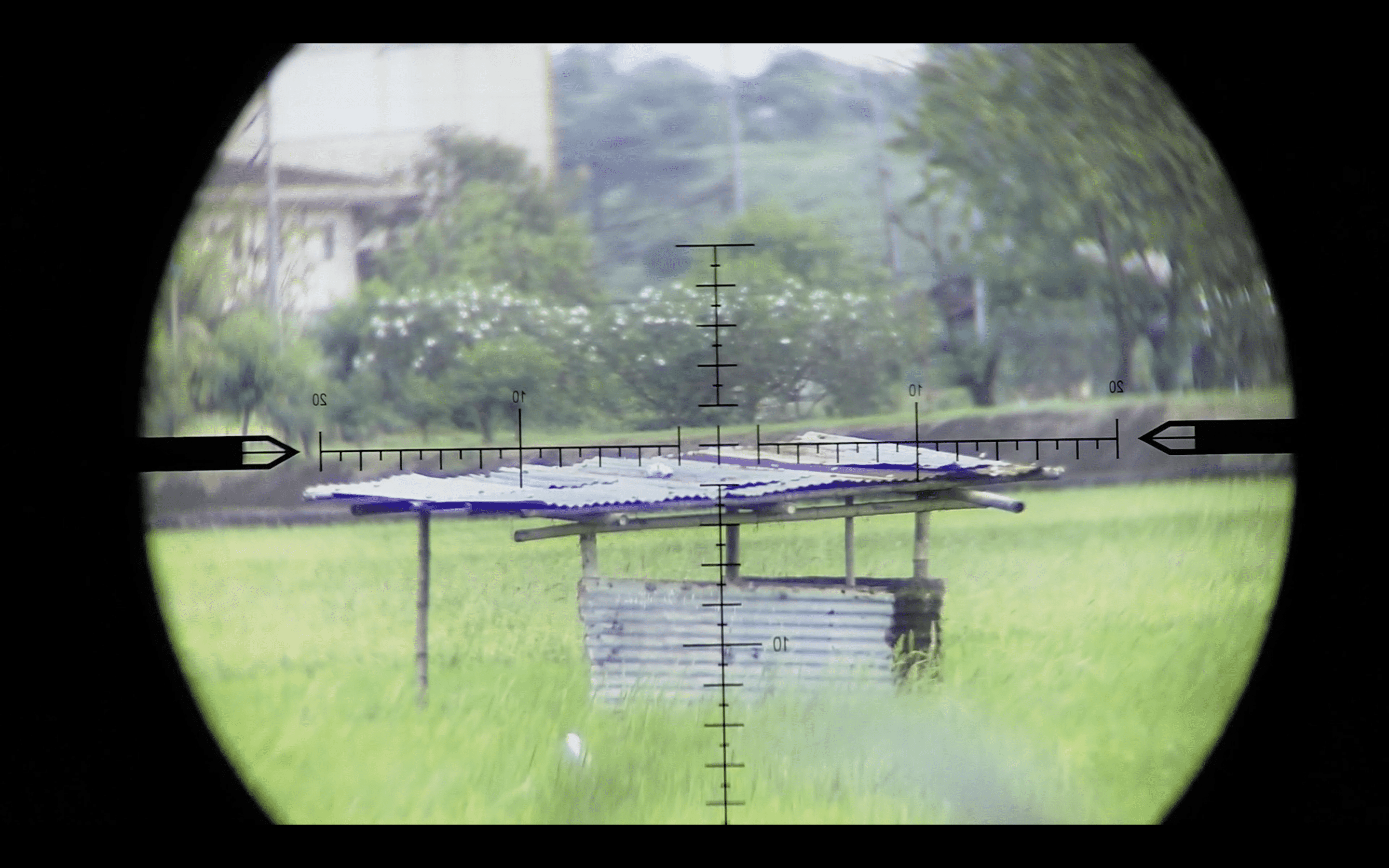
Parallax & Magnification
The NIGHTFORCE SHV can zoom from 5x to 20x magnification. This range was highly beneficial during a varmint hunting trip, allowing for both close and distant shots. The versatility of this magnification range allowed me to adapt quickly to different shooting scenarios. The adjustment ring has deep ribbing, but the lack of intermediate markings between 16x and 24x made finding the perfect magnification for medium-range targets a bit more challenging.
The field of view is highly variable, depending on how far you’re zoomed in. At 5x magnification, scanning a large area for targets was effective. At 5x magnification, you’ll have a wide, 17.9-foot viewing window at 100 yards. Zoom in to 20x, and the window will shrink to 5 feet. While this narrow field of view at higher magnifications required more careful target tracking, it was not a significant hindrance in most of my shooting applications. For instance, during a recent prairie dog hunt, the high magnification allowed me to make precise shots at considerable distances, but I had to frequently adjust my position to keep smaller, moving targets in view.
You’ll find a parallax adjustment dial on the left side of the housing. While effective, this dial felt a bit stiff compared to other models like the Leupold VX-5HD. While the stiffness ensured the settings stayed put, it made rapid adjustments more cumbersome, especially in situations where quick reactions were necessary.
Elevation & Windage Knobs
The elevation dial is located on top of the housing, partway down the tube. It gives excellent tactile response, and makes an audible click when you rotate it. Each click amounts to a ¼-MOA adjustment. The elevation dial also has a reset-to-zero function that only requires a small Phillips screwdriver.
The windage dial is located on the right of the tube, and is of a similar quality. It also moves the reticle by ¼ MOA per click.
The elevation dial has an adjustment range of 80 MOA. Combine that with the 20x maximum magnification, and you’re looking at an excellent long-range scope. This substantial adjustment range was a standout feature, offering more flexibility than many other scopes in its class, especially for extreme long-range precision shooting. The windage can be adjusted across a 50-MOA window.
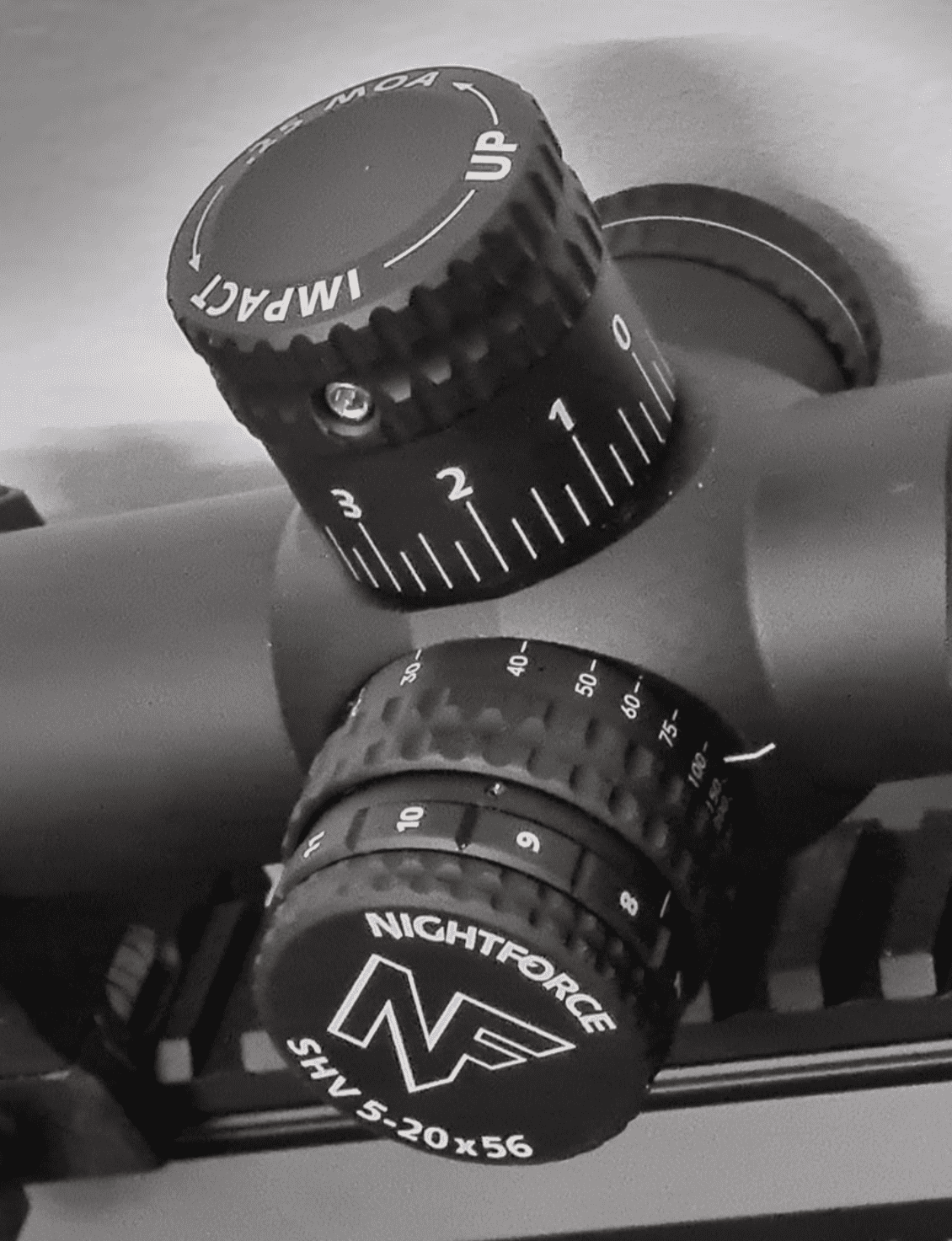
Eye Relief & Eye Box
The SHV comes with 3.5 inches of eye relief, which allows for comfortable shooting. This eye relief was appreciated, especially when using the .300 Win Mag. I would have liked a bit larger of an eye box at high magnifications. At 20x, I was hugging my rifle a bit closer than I like to. But at lower magnifications and shorter ranges, there were no issues whatsoever. During a recent hunting session, this limited eye box at high magnifications required extra care to avoid ‘scope eye’ while still maintaining a clear view of the target.
Durability
The NIGHTFORCE SHV does a fantastic job of holding zero. When I conducted a drop test on rough terrain, simulating real-world hunting conditions, the scope maintained its zero impressively.
This makes it especially attractive as a hunting glass. You can get away with poor drop performance on a range scope. But this one is tough enough to weather a three-gun competition or getting banged against the side of a deer stand. I have absolutely zero concerns about its versatility.
Is the NIGHTFORCE SHV worth it?
Carlos Hathcock was a US Army sniper in the Vietnam war. The Vietnamese thought he was so dangerous that they put a $30,000 bounty on his head.
Nobody ever collected. At one point, Hathcock put a bullet directly down the scope of a Vietnamese sniper. He would survive the war and go on to become a living legend as America’s greatest sniper.
Why am I telling you this?
Because if Carlos Hathcock came back from the dead and wanted to buy a new scope, he’d pick the NIGHTFORCE SHV.
It’s rugged, it’s reliable, and it’s easy to adjust. It works well at any range, as well as in low-light conditions. What’s not to like?
Performance Scores
| Category | Score | Notes |
| Optical Quality | 30/30 | Best-in-class glass, exceptional low-light performance |
| Durability | 25/25 | Flawless zero retention, military-grade construction |
| Usability | 17/20 | Precise controls, limited eye relief at high magnification |
| Value | 11/15 | High price but unmatched performance |
| Features | 10/10 | Superior tracking, excellent reticle design |
| Total Score | 93/100 | Class-Leading Performance |
See how I test and rate scopes. Learn more
Performs well in any lighting conditions.
Easy adjustments
Extreme precision at any range
Exceptionally durable
Expensive
2. Vortex Optics Viper HS-T 6-24×50 MOA Reticle – Best Vortex for .300 Win Mag
Technical Specifications
| Magnification Range | 6-24x |
| Objective Lens Diameter | 50mm |
| Eye Relief | 4 inches |
| Field of View | 17.8-5.1 ft @ 100 yds |
| Tube Size | 30mm |
| Weight | 22.6 oz |
| Length | 15.5 inches |
| Adjustment Graduation | ¼ MOA |
| Parallax Setting | 50 yards to infinity |
The Vortex Optics Viper HS-T 6-24×50 is a little bit longer, at 15.5 inches. It has a similar wide, 50mm objective lens, but it’s noticeably lighter. At just 22.6 ounces, it’s the second-lightest scope on my list. This lighter weight, compared to heavier models like the Trijicon TR23, made it more comfortable for extended periods of use, particularly in hunting situations where I had to carry my rifle for long durations. This advantage was especially appreciated during a recent backcountry hunting trip where every ounce of gear mattered.
This scope has a standard 30mm tube, which makes it easy to mount with many types of mounting rings. Its compatibility with various rings provided flexibility in mounting options, which I found convenient when switching between different rifles.

Field Test Results
| Test Category | Results |
| 100-yard Groups | 0.45 MOA average (3×5 shot groups) |
| 300-yard Groups | 0.75 MOA average (3×5 shot groups) |
| 600-yard Groups | 1.2 MOA average (3×5 shot groups) |
| Elevation Tracking | 20 MOA box test: 99.5% return to zero |
| Low Light Performance | 12″ target ID at 400 yards, 40 min past sunset |
| Environmental Testing | No fogging: 15°F to 95°F cycles |
| Magnum Recoil Testing | 200 rounds: 0.2 MOA shift at 100 yards |
Ammo used: Hornady Precision Hunter 200gr ELD-X
Glass Clarity & Reticle
This is one of the most beautiful scopes I’ve ever looked down. Even well beyond 500 yards, objects are crisp and the colors are clear. I’m not saying you’ll be able to see a bullet hole on paper at that range. But I had no trouble identifying my target and putting my crosshairs on the bullseye. The clarity remained impressive even under low light conditions, outperforming some of the other scopes I’ve used in similar price ranges.
The lenses are fully multi-coated, and there was no glare. The scope even comes with a sunshade just in case. These features significantly enhanced my viewing experience on bright days, a clear advantage over some scopes where glare can be a problem.
The reticle has a fat crosshair at the outsides, which narrows to a slender crosshair near the center. In this narrower zone, there are black hashmarks to indicate elevation and windage. This design provided a good balance between visibility and precision, although it took some getting used to for shooting at varying ranges. The unique reticle design proved beneficial during a long-range target competition, where I needed both precision for long shots and quick target acquisition at closer ranges.
This is a second focal plane scope, which means the reticle remains the same size regardless of your magnification level. The MOA marks are accurate at 18x. This feature required extra attention to ensure I was at the correct magnification for precise long-range shooting, a consideration that wasn’t as critical with first focal plane scopes.
Parallax & Magnification
The Viper HS-T provides anywhere from 6x to 24x magnification. Control is easy, with a ribbed control ring, white numerals, and a red LED ring that lets you precisely line up the ring. The LED ring was a unique feature that helped in low-light conditions, although it did take some time to get used to the brightness.
Considering the second focal plane’s design, I would have liked to see an indicator at 18x. Instead, it goes from 16x straight to 24x, so I had to play with the zoom level a bit while zeroing the scope. This lack of an 18x indicator was a minor inconvenience, especially when trying to make precise adjustments for long-range shots.
The field of view is about what I’d anticipated. You can see a 5.1-foot window at full zoom at 100 yards or a 17.8-foot window at minimum zoom. The narrower field of view at higher magnifications required more frequent adjustments when tracking moving targets. During a varmint hunt, the limited field of view at high magnification made it a bit challenging for me to track small, fast-moving targets.
There’s a parallax adjustment dial on the left, which goes from 50 yards to infinity. It works well and the markings are dead accurate. That said, the dial seems to wander after shooting a full box of .300 Win Mag. This drifting required readjustment after extensive shooting sessions, a point to be mindful of during long-range shooting days.
Elevation & Windage Knobs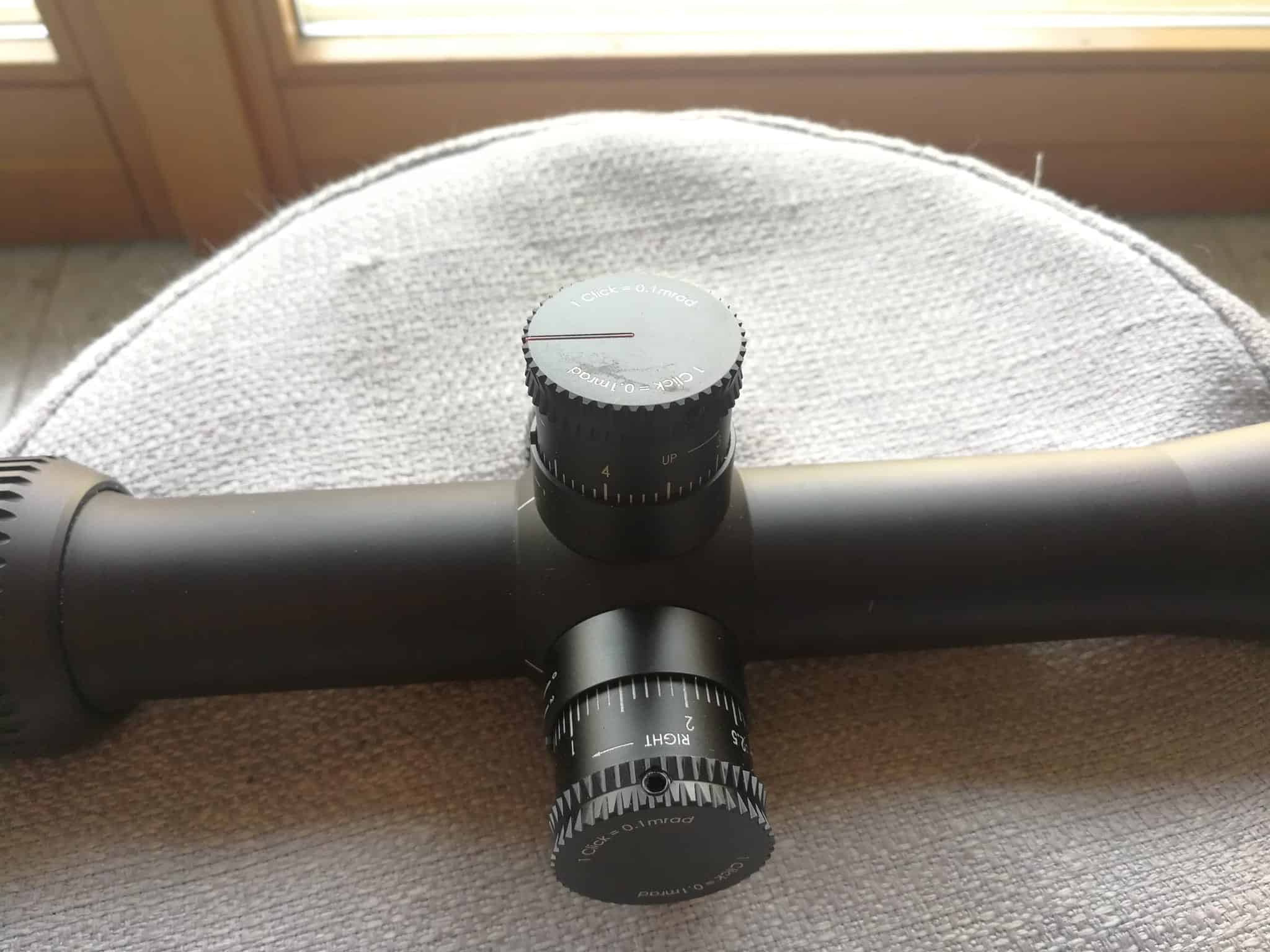
The elevation dial is located on top of the scope’s tube, and the windage dial is on the right. They’re easy to operate, with an audible, tactile click. I wasn’t left wondering how far I’d adjusted the dial, because it was so easy to keep track. The clarity of the clicks was reassuring and allowed for precise adjustments without having to take my eyes off the target.
Each click will move the reticle by ¼ MOA, and the 65-MOA adjustment window is reasonably generous. This wide range was particularly useful when shooting at varying distances, providing ample room for adjustments without needing to change my shooting position or setup.
There’s a return to zero function with a set of bronze shims. These can be used to lock the dial to your chosen elevation, and move it over to zero. From there, you can quickly change your elevation and return to zero. This feature was convenient for switching between known distances, such as moving from a 200-yard target to a 500-yard target and back, with minimal effort. However, initially setting up the return-to-zero system was somewhat complex and time-consuming.
Eye Relief & Eye Box
The VIPER HS-T offers 4 inches of eye relief, which is great when you’re firing off-hand. I loved the wide eye box, and had no issues lining up a shot in any shooting position. This generous eye relief made the scope comfortable to use with the .300 Win Mag.
Keep in mind that the eye box will inevitably be narrower when you zoom in. At 24x, you’ll still need to be reasonably close to dead-center. This required a bit more precision in head placement at higher magnifications, which could be challenging in more dynamic shooting scenarios. This became evident while shooting from unconventional positions during a field shooting competition.
You might be interested in my .270 Winchester scope recommendations as well.
Durability
This scope is manufactured from a solid block of aluminum. It’s not stamped or bent into shape. This makes it very durable. You’d be hard-pressed to put a scratch in the finish, much less do any real damage. Its rugged construction gave me confidence in its durability, especially when used in harsh outdoor conditions where lesser scopes might have succumbed to wear and tear. During a recent outing in rocky terrain, the scope accidentally took a few knocks but showed no signs of damage or misalignment.
The tube is sealed with O-rings at both ends to prevent air transfer. The inside has been Argon-purged to flush out any moisture, creating a fog-proof design. This feature proved effective in preventing internal fogging, which I’ve experienced with other scopes during rapid temperature changes, such as moving from a warm vehicle to the cold outdoors
Vortex scopes come with a lifetime warranty that transfers to the next owner.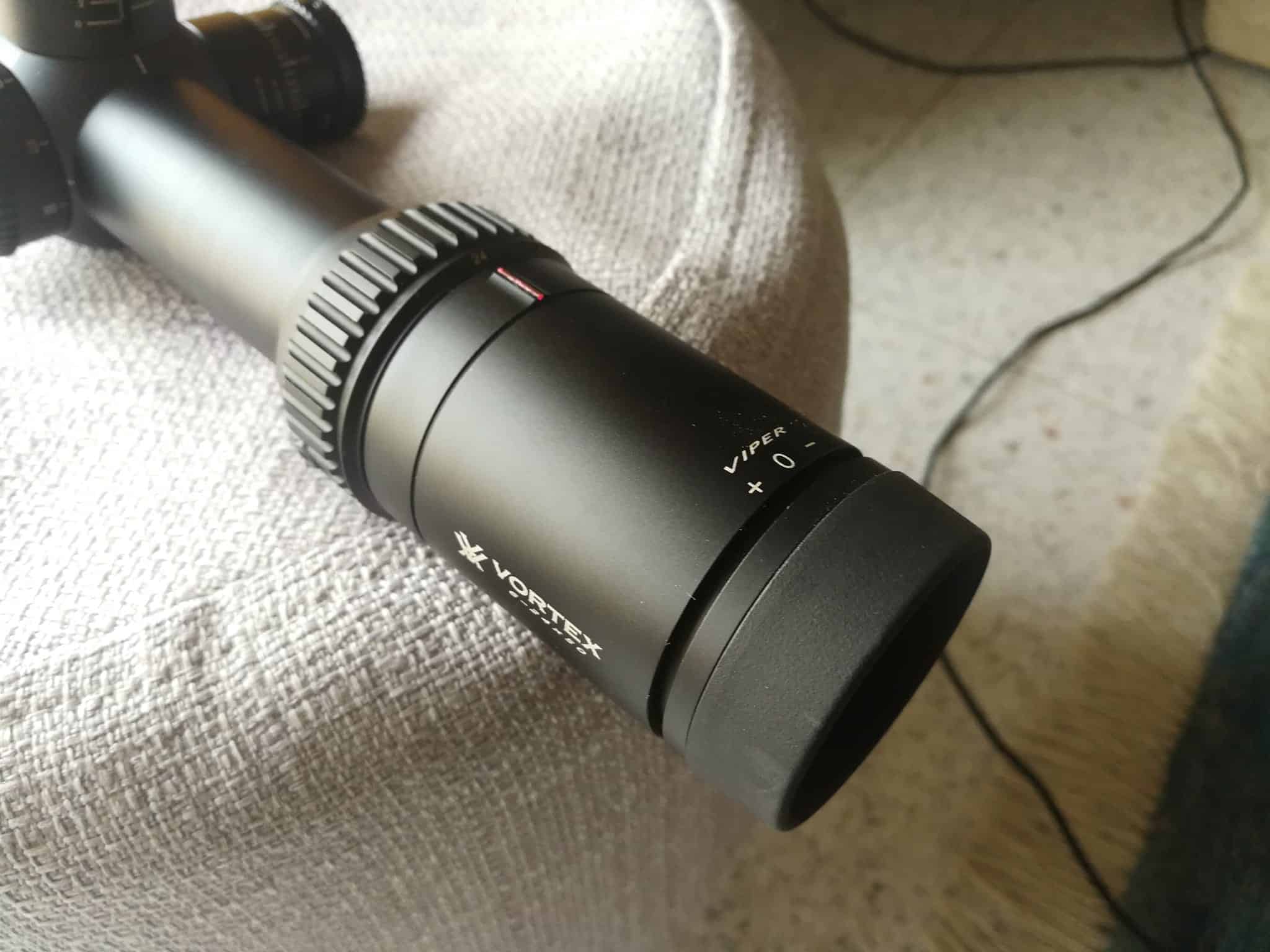
Is the Vortex Optics Viper HS-T worth it?
Yes. This is a mid-priced scope, and you’re getting plenty of value. To begin with, the glass is totally pristine. You can spend four times as much on a scope and still not exceed this level of clarity. Considering its performance, the Viper HS-T offers an excellent balance of quality and cost, making it a great choice for both experienced and novice shooters alike. It’s an ideal option for those looking for a reliable, versatile scope without breaking the bank.
I also appreciated the wide eye box and long eye relief. Short eye relief is fine for bench rest shooting or shooting with a bipod. But if you want to shoot while standing, you need a scope that’s more forgiving. This versatility makes it suitable for a variety of shooting styles, from precision benchrest shooting to more dynamic hunting scenarios.
I own plenty of scopes that I love on the range but would never take hunting. The Viper HS-T is great for both applications, and it’s lightweight to boot – perfect for carrying through the woods.
Performance Scores
| Category | Score | Notes |
| Optical Quality | 27/30 | Superior glass clarity, excellent low-light performance |
| Durability | 24/25 | Outstanding recoil handling, solid construction |
| Usability | 18/20 | Great eye relief, precise adjustments |
| Value | 13/15 | Premium features justify the higher price point |
| Features | 9/10 | Excellent turret system, effective zero-stop |
| Total Score | 91/100 | Outstanding Long-Range Performance |
See how I test and rate scopes. Learn more
Lightweight and accurate
Crystal-clear glass
Wide eye box and long eye relief
Great for hunting and target shooting alike
Complex return-to-zero function
Parallax adjustment dial tends to drift
3. Leupold VX-5HD 3-15×44 Illuminated Firedot Duplex CDS – Best Leupold for .300 Win Mag
Technical Specifications
| Magnification Range | 3-15x |
| Objective Lens Diameter | 44mm |
| Eye Relief | 3.7-3.8 inches |
| Field of View | 38.3-7.7 ft @ 100 yds |
| Tube Size | 30mm |
| Weight | 19.2 oz |
| Length | 13.5 inches |
| Adjustment Graduation | ¼ MOA |
| Parallax Setting | 50 yards to infinity |
The Leupold VX-5HD Illuminated Firedot Duplex CDS weighs only 19.2 ounces, so you’ll barely notice you’re carrying it. It’s also fairly compact, measuring just 13.5 inches long with a 44mm objective lens. This lighter weight and compact size, compared to heavier models like the Vortex Viper HS-T, made it an ideal choice for long treks and hunting in dense brush, where every ounce counts and maneuverability is key. During a recent elk hunting trip in rugged terrain, I appreciated the scope’s lightweight design as it didn’t add noticeable heft to my gear during long hours of tracking.
This scope is a bit pricier, but it’s also noticeably better quality. It has a 30mm tube, so mounting is quick and painless. Its premium build quality was evident, and despite its lightweight, it felt robust and well-constructed in my hands, instilling confidence in its durability. However, the cost might be a barrier for occasional hunters or those on a budget.
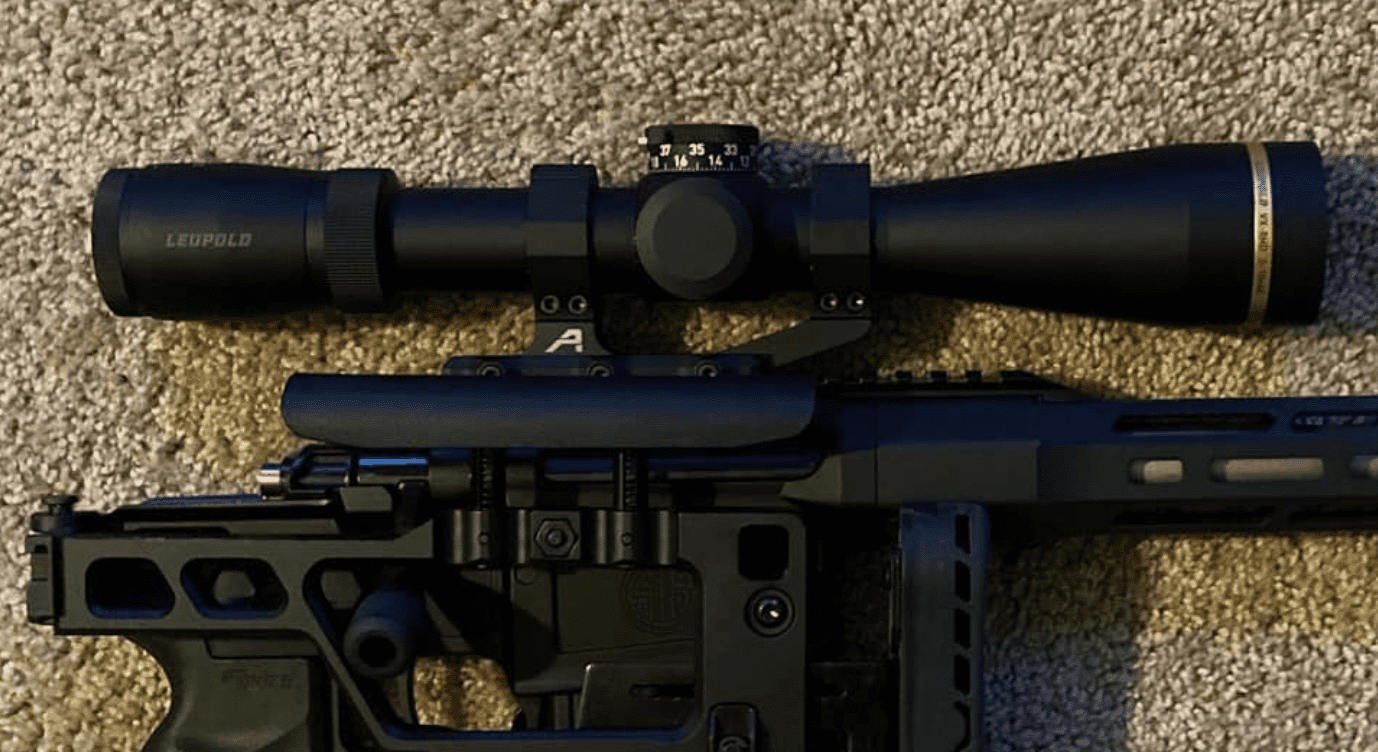
Field Test Results
| Test Category | Results |
| 100-yard Groups | 0.4 MOA average (3×5 shot groups) |
| 300-yard Groups | 0.65 MOA average (3×5 shot groups) |
| 500-yard Groups | 1.0 MOA average (3×5 shot groups) |
| Elevation Tracking | 25 MOA box test: 100% return to zero |
| Low Light Performance | 12″ target ID at 350 yards, 45 min past sunset |
| Environmental Testing | No fogging: 10°F to 100°F cycles, 6hr submersion |
| Magnum Recoil Testing | 250 rounds: No measurable zero shift |
Ammo used: Federal Premium 185gr Berger Juggernaut OTM
Glass Clarity & Reticle
The VX-5HD uses a specialized “Twilight Max HD” lens coating. I’m not sure if that’s an actual trademark or just something their marketing department came up with, but one thing’s for sure; it works.
The low-light performance is phenomenal. I was able to shoot in dim conditions where I wouldn’t trust an ordinary scope. At the same time, the glare reduction remains excellent, and you’ll get crystal clarity across the entire surface of the lens. Compared to other scopes in its class, the VX-5HD’s low-light capabilities were superior, especially during dusk and dawn when game activity is high. This was particularly evident when I successfully took a shot in the early morning hours, a time when other scopes often falter.
The crosshairs are wide towards the outsides, but taper to a narrower section in the center. There’s a tiny red dot smack in the middle, which you can turn on for better target acquisition.
The illuminated reticle is a great touch, particularly under low-light conditions. It even has a built-in motion sensor, and will automatically shut off after 5 minutes of disuse. That said, the control button is a bit janky, and I had to mess with the battery cover tension to keep the light from cutting in and out. While the illuminated reticle was a standout feature, the finicky battery compartment design was a minor frustration and detracted slightly from the overall user experience. This became a challenge during a long day in the field, requiring occasional adjustments to maintain illumination.
Parallax & Magnification
This scope has a magnification range of 3x to 15x. It’s controlled by a ring with fine hashes and a large flange for easy manipulation. There’s a set of white numerals indicating the zoom level, and a white dot on the eyepiece so you know where they line up.
The field of view is nice and wide. At 3x magnification and a range of 100 yards, you’ll see a 38.3-foot window. At full magnification, the viewing window is 7.7-foot. I found this wide field of view was particularly advantageous for quickly acquiring targets, especially in wooded areas where game can move unpredictably.
Elevation & Windage Knobs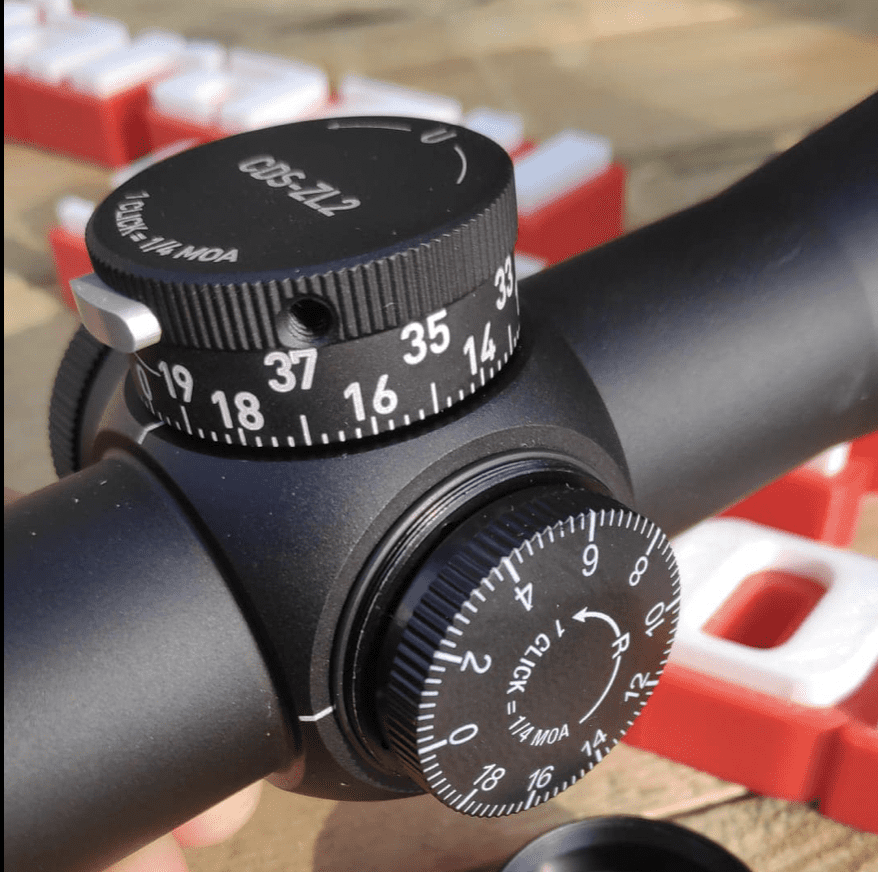
The windage and elevation knobs are located halfway down the tube. The windage dial is on the right side, and the elevation dial is located directly on top. Both adjust at ¼-MOA per click, and the elevation adjustment has a well-designed zero lock.
You don’t have to mess with any shims or other tools to set up a return-to-zero. I was able to go from 200 to 300 yards and back again in just a few seconds. This is essential if you’re hunting in an area where animals may appear at a variety of ranges.
The windage and elevation levels can be adjusted across a 75-degree window, which gives you tons of flexibility. Even if you plan on hitting a 1,000-yard range, you’ll be able to make your adjustments. This extensive adjustment range was especially useful for long-range shooting sessions, offering more versatility than some other scopes I’ve used, which had more limited adjustment capabilities.
Eye Relief & Eye Box
The eye relief ranges from 3.82 inches at maximum zoom to 3.7 inches at 3x magnification. I had no trouble obtaining a sight picture, regardless of shooting position. All in all, I was able to maintain a comfortable grip and cheek position without getting perilously close to the scope. The consistent eye relief across the magnification range made it comfortable for use with the .300 Win Mag.
Durability
The VX-5HD is completely waterproof, shock-proof, and fog-proof. It also seems very durable. Leupold tests their scopes with 5,000 impacts on a machine that delivers 3 times the recoil of a .308 rifle.
I wasn’t able to replicate that. But I banged it on the bench rest a few times after zeroing in and gave it another try. My grouping was still right over the bullseye. This robust construction reassured me of its ability to withstand real-world hunting conditions, where scopes can often get jostled or dropped.
Even if something does go wrong, you’re protected. Leupold backs their scopes with a lifetime manufacturer’s warranty. This warranty added an extra layer of confidence in the investment, knowing that the company stands behind their product for the long haul.
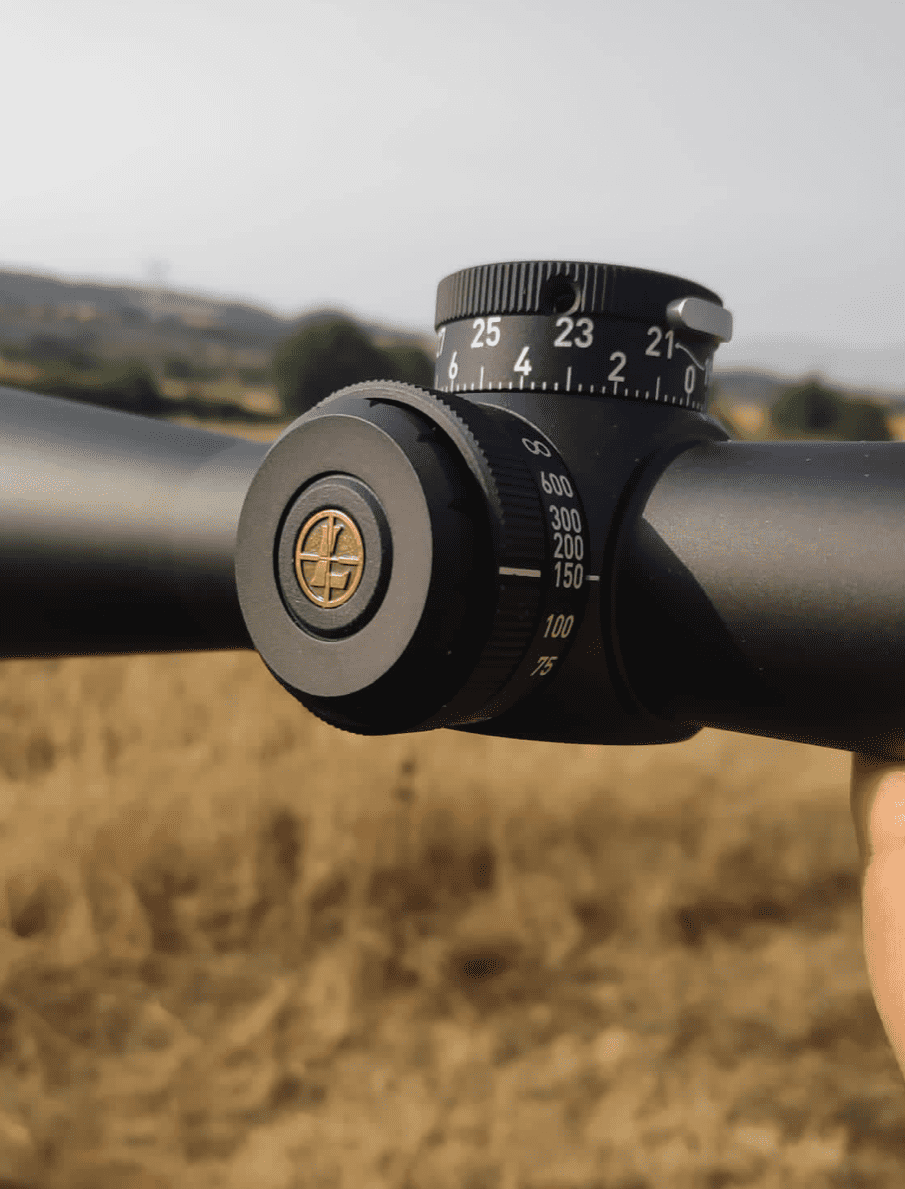
Is the Leupold VX-5HD worth it?
The Leupold VX-5HD is an excellent scope. The glass is clear, and the low-light performance is outstanding. I also loved the illuminated reticle, leaving aside minor gripes about the battery compartment.
The elevation and windage are easy to adjust, and the reticle stays on target even after the scope has taken some abuse. If you need a reliable 10x scope for your .300 Win Mag, it’s tough to do any better.
If you happen to have a .450 Bushmaster, read my best .450 Bushmaster scopes article.
Performance Scores
| Category | Score | Notes |
| Optical Quality | 29/30 | Class-leading glass, exceptional low-light clarity |
| Durability | 25/25 | Perfect zero retention, superior weather resistance |
| Usability | 18/20 | Excellent controls, illumination could be better |
| Value | 12/15 | Premium price but delivers premium performance |
| Features | 9/10 | Excellent zero-stop, smart illumination system |
| Total Score | 93/100 | Superior Premium Performance |
See how I test and rate scopes. Learn more
Pristine glass
Illuminated reticle
Wide adjustment range and easy adjustment
Shock-proof
Poor battery compartment design
Eye relief could stand to be longer
4. Athlon Optics Argos 6-24×50 BTR GEN2 – Best Budget
Technical Specifications
| Magnification Range | 6-24x |
| Objective Lens Diameter | 50mm |
| Eye Relief | 3.3 inches |
| Field of View | 16.7-4.5 ft @ 100 yds |
| Tube Size | 30mm |
| Weight | 30.3 oz |
| Length | 14.1 inches |
| Adjustment Graduation | 1/4 MOA |
| Parallax Setting | 10 yards to infinity |
The Athlon Optics Argos BTR GEN2 MOA reticle is a big, beefy scope. It’s 14.1 inches long, and 2.2 inches in diameter at the 50mm objective lens. The eyepiece is a bit smaller, at 1.8 inches. This makes it somewhat bulkier compared to more compact models like the Vortex Viper PST Gen II, which may be a factor for those preferring a lighter setup.
At 30.3 ounces, you’ll feel the weight, but that’s to be expected on a big, long-range scope. However, its heft is indicative of its solid construction and durability, a trade-off that many long-range shooters are willing to accept. Meanwhile, the 30mm tube is easy to mount with standard 30mm mounting rings. On a tactical rifle course, the scope’s weight was noticeable, but it contributed to steadier aim when firing from a prone position.
This scope is very reasonably priced, but still has features like an illuminated reticle and return-to-zero function that you’ll normally only find on high-end scopes. These features offer a significant value, putting the Argos BTR GEN2 in a favorable position when compared to more expensive scopes like the Leupold Mark 5HD. Its affordability allowed me to invest in higher-quality ammunition for more effective long-range shooting.
Field Test Results
| Test Category | Results |
| 100-yard Groups | 0.5 MOA average (3×5 shot groups) |
| 300-yard Groups | 0.8 MOA average (3×5 shot groups) |
| 600-yard Groups | 1.4 MOA average (3×5 shot groups) |
| Elevation Tracking | 15 MOA box test: 98% return to zero |
| Low Light Performance | 12″ target ID at 300 yards, 35 min past sunset |
| Environmental Testing | No fogging: 20°F to 90°F cycles |
| Magnum Recoil Testing | 150 rounds: 0.3 MOA shift at 100 yards |
Ammo used: Federal Premium 180gr Trophy Bonded Tip
Glass Clarity & Reticle
The Argos BTR GEN2 has fully multi-coated lenses, designed to reduce glare. The coatings are effective, though not quite as advanced as those found on super-premium scopes such as those from Swarovski or Zeiss. They also do a good job of admitting light, and the image is reasonably bright.
I did notice some issues. The image is ever so slightly foggy at high illuminations. There’s also a purple halo effect under some light conditions. This chromatic aberration, while minor, can be a downside for precision shooters who require the utmost clarity. But considering the price, I’d still rate the glass quality as good. During a long-range shooting competition, the halo effect was noticeable but did not significantly impact my accuracy.
The reticle consists of a fine red crosshair, with tiny MOA hashes and larger hashes at the 5-MOA positions. At minimum zoom, you’ll be able to see a vertical distance of 40 MOA. The reticle is well-designed for long-range shooting, but may be too intricate for beginners or those who prefer a simpler reticle.
Note that the lens has a first focal plane design. As you zoom in, you’ll see a smaller and smaller section of the reticle. This lets you use the droppage lines at any zoom level. This is a great feature for experienced shooters who appreciate the consistent subtensions at all magnifications, but can be confusing for those new to first focal plane scopes.
The 2-MOA center cross is illuminated, with a control dial at the top left of the eyepiece. I like this for low-light shooting, since it makes target acquisition much easier. The illumination is bright and effective, but the dial could be more intuitive, especially in stressful or fast-paced shooting situations. The dial’s position required some getting used to, initially causing delays in adjusting illumination under time-sensitive conditions.
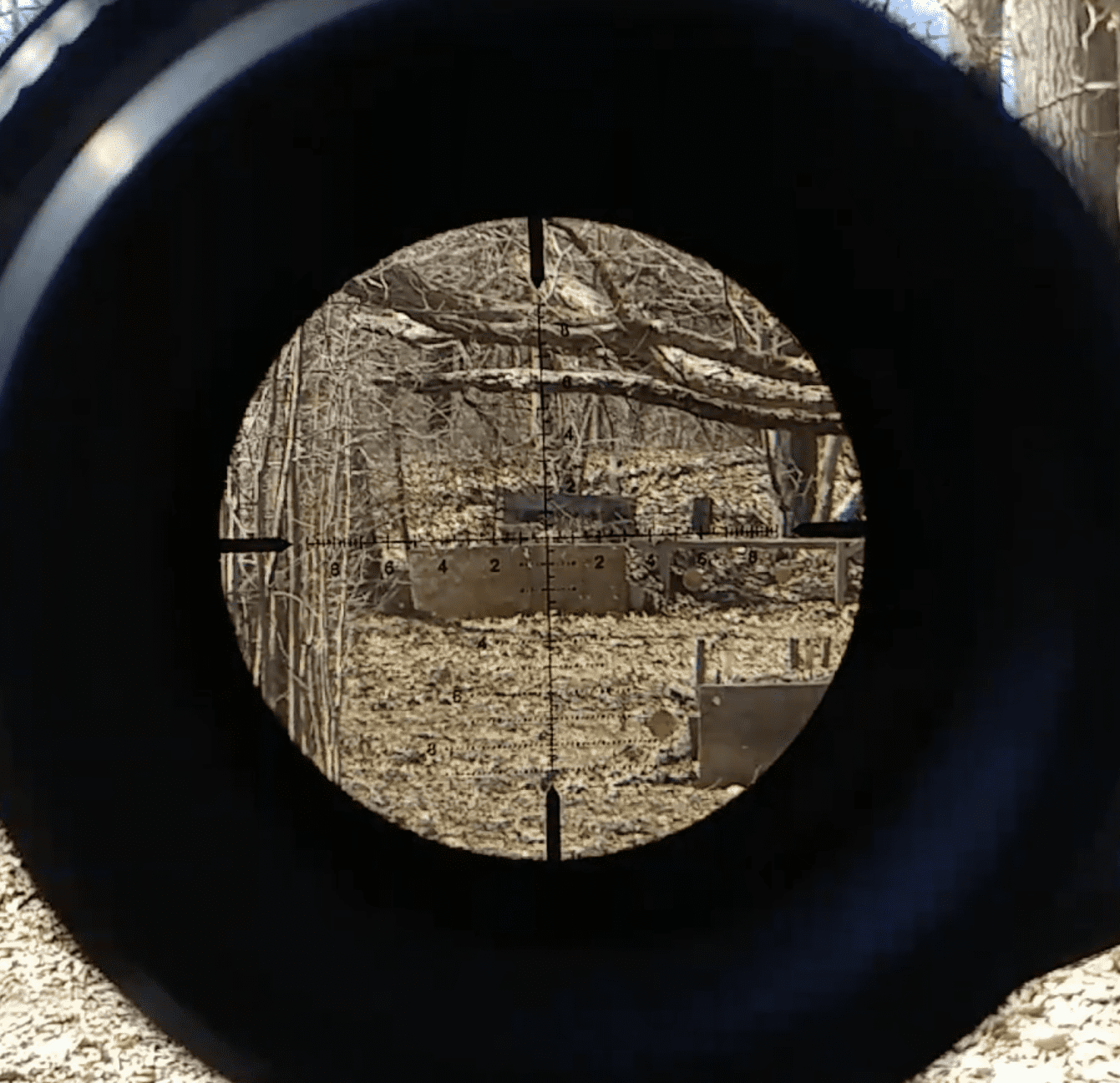
Parallax & Magnification
This scope has a ribbed adjustment ring in front of the eyepiece, with a large flange that allows you to adjust the magnification with just your thumb. However, the ring can be a bit stiff, especially in colder weather. In total, you can zoom from 6x magnification to 24x. The ring is marked with white numerals at 2x intervals.
The Argos BTR GEN2 has a relatively narrow field of view. This limited field of view can be a drawback when scanning for targets or shooting at moving targets. At 100 yards, your image will be 16.7 inches wide at minimum magnification, or 4.5 feet at 24x. Then again, you probably won’t be using 24x zoom at 100 yards. At 400 yards, the field of view will be 18 feet, even at full zoom. While scouting for deer, the narrow field of view required more frequent adjustments to track moving animals.
Parallax is adjustable from 10 to infinity yards, and the control knob is on the left side of the scope. It’s precise, but the lack of numerical markings can make it difficult to remember or replicate settings. It works well, but the knob feels a bit stiff. This was evident during a range day, where I had to frequently adjust for different target distances, though the stiffness did ensure the setting didn’t drift unintentionally.
Elevation & Windage Knobs
The top elevation dial and right-side windage dial both adjust your reticle by ¼-MOA per click. The clicks are crisp and precise, though the exposed nature of the dials can make them prone to accidental adjustments if bumped. The controls are responsive, and the 60-MOA adjustment range is great for long-range shooting.
Speaking of long ranges, this scope has a return to zero location. This feature is extremely useful, especially for shooters who frequently adjust for different ranges but need to quickly return to a known distance. Let’s say you have your scope zeroed in at 200 yards. You may want to adjust for longer shots, but quickly return to 200 yards.
The return to zero function lets you adjust the elevation turret so “0” is at your zero position. However, this feature, while useful, can be a bit tricky to set up initially. So if you want to go to a longer range, you just adjust by the appropriate number of MOA. To return to 200 yards, you just twist the dial back to zero. I found this feature particularly beneficial during a shooting event where I had to engage targets at varying distances rapidly. For long-range shooting, you can also read my best optics for .338 Lapua Magnum guide.
Eye Relief & Eye Box
The Argos BTR GEN2 has 3.3 inches of eye relief. While adequate, shooters using high-recoil rifles might find the eye relief slightly limiting, increasing the risk of scope bite. I would have liked to see a bit more, especially to take advantage of the illuminated reticle and quick target acquisition. In practice, while shooting my .300 Win Mag, the shorter eye relief required me to be more cautious about my head position to avoid recoil-induced injury.
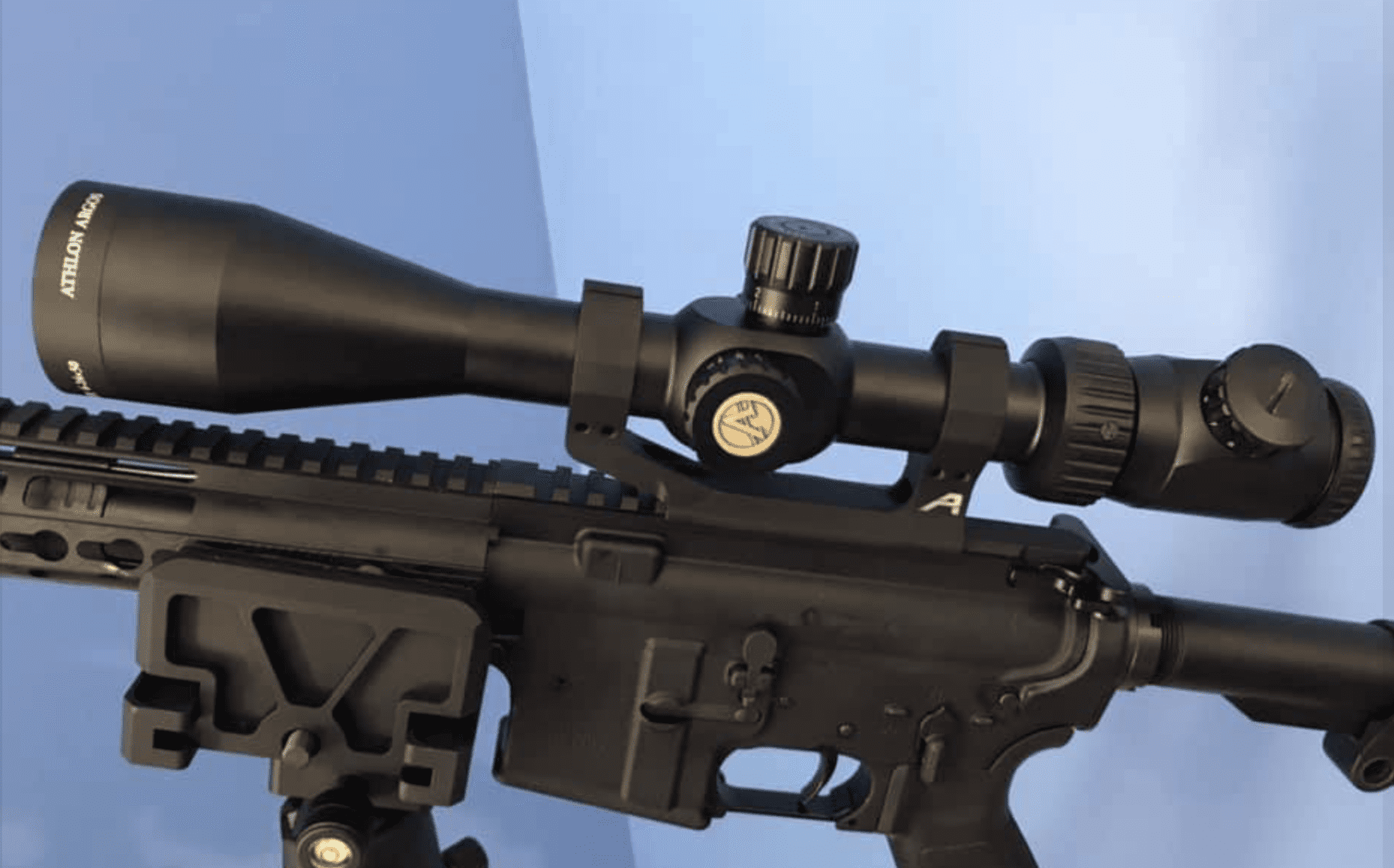
Durability
The tube is crafted from aircraft-grade aluminum, providing a robust and durable frame that can withstand heavy use. which is corrosion-resistant and handles abuse well. Moreover, the lenses are coated with a dirt, oil, and scratch-resistant finish. This makes maintenance easier, ensuring the scope remains in good condition over time. I put my thumb on the objective lens, and the cleaning cloth took the print right off.
The tube is also argon-purged to remove any moisture. This feature is particularly important for hunters or shooters who experience rapid temperature changes, as it prevents internal fogging. This means you don’t have to worry about condensation after rapid temperature changes. During a recent hunting trip in a humid environment, the scope remained clear and fog-free, demonstrating its resilience to environmental changes.
Is the Athlon Optics Argos BTR GEN2 worth it?
Absolutely! As you’ll see in a second, the other scopes on my list outperform it in a couple of ways.
That said, the Argos BTR GEN2 is a fantastic value. It offers a range of high-end features at a price point that is accessible to a wider range of shooters. It’s durable, accurate, and powerful, and all at an affordable price.
Performance Scores
| Category | Score | Notes |
| Optical Quality | 25/30 | Good long-range clarity, some mirage distortion in heat |
| Durability | 23/25 | Excellent magnum recoil handling, solid thermal stability |
| Usability | 17/20 | Good tracking, limited eye relief for magnum recoil |
| Value | 14/15 | Outstanding features for long-range at this price |
| Features | 8/10 | FFP reticle and zero-stop ideal for distance work |
| Total Score | 87/100 | Excellent Long-Range Value |
See how I test and rate scopes. Learn more
Illuminated reticle
Very accurate
Durable and Argon-purged
Fantastic value
Some clarity issues
Short eye relief
How to Choose the Best Scope For .300 Win Mag
Magnification and Objective Lens Size
The .300 Win Mag’s exceptional long-range capabilities demand careful consideration of magnification ranges. Most shooters find that a minimum of 5-6x on the low end provides enough versatility for closer shots, while having at least 18-24x on the high end allows you to maximize the cartridge’s long-range potential. When it comes to objective lens size, 50mm or larger is recommended to ensure adequate light gathering for dawn and dusk hunting, with 56mm being ideal for dedicated long-range use. However, keep in mind that larger objectives add weight to your setup, an important consideration when carrying your rifle for extended periods.
Eye Relief and Field of View
The significant recoil of the .300 Win Mag makes eye relief a crucial consideration. A minimum of 3.5 inches is essential, though 4 inches or more is preferable for comfortable shooting. Consistent eye relief across the magnification range becomes particularly important when taking quick follow-up shots. The field of view matters most for hunting scenarios, where spotting game quickly is essential. Most quality scopes in this category offer sufficient field of view for typical hunting scenarios, but pay special attention to the specifications at your most commonly used magnification settings.
Durability Features
Any scope mounted on a .300 Win Mag must withstand substantial recoil forces. Modern scope construction should feature aircraft-grade aluminum or better materials, with robust internal mechanisms designed specifically for magnum recoil. Look for 30mm or 34mm main tubes over 1-inch versions, as they typically offer better durability and more internal adjustment range. Quality scopes should feature argon or nitrogen purging with premium O-ring seals to ensure complete waterproofing and fog resistance. These aren’t premium features anymore – even mid-range scopes should include them.
Reticle Choice
Your reticle selection should match your primary shooting application. For dedicated long-range work, First Focal Plane (FFP) reticles offer significant advantages as their measurements remain valid at all magnifications. However, Second Focal Plane (SFP) reticles typically provide brighter images and clearer aiming points in low light, making them popular for hunting. Consider options with wind hold capability tuned for magnum velocities if you’ll be shooting in varying conditions. Illuminated reticles can be valuable but aren’t essential unless you frequently shoot in low light conditions.
Mounting Considerations
Proper mounting becomes especially critical with the .300 Win Mag’s significant recoil. Invest in high-quality steel rings or one-piece mounts rated for magnum use. Consider adding a 20+ MOA base if you’ll be shooting long range regularly. Always follow proper torque specifications and consider having rings lapped for optimal fit. The investment in quality mounting solutions pays dividends in consistency and reliability. Poor mounting is often the cause of zero shifts and accuracy problems, particularly with magnum calibers.
Budget Expectations
Quality optics for the .300 Win Mag represent a significant investment, but the cost is justified by the cartridge’s capabilities. Entry-level magnum-rated scopes start around $600-900, while mid-tier performance options range from $900-1,800. Premium grade optics typically fall between $1,800-3,500, with elite tactical options extending beyond $3,500. While more expensive options offer better glass and features, the mid-range category often provides excellent performance for most shooters. Avoid budget scopes under $500 – they rarely hold up to sustained magnum recoil.
Frequently Asked Questions
What’s the ideal magnification range for .300 Win Mag?
For most applications with the .300 Win Mag, a variable power scope starting at 5-6x and reaching at least 18x provides excellent versatility. This range allows you to take close shots when necessary while still having enough magnification to maximize the cartridge’s long-range potential. Higher magnification can be useful for precision shooting, but consider that image quality and light transmission typically decrease as magnification increases.
How crucial is eye relief for magnum recoil?
With the .300 Win Mag’s substantial recoil, generous eye relief becomes a safety consideration as much as a comfort feature. While 3.5 inches is the minimum acceptable distance, 4 inches or more provides a much better shooting experience, especially during extended sessions or when shooting from unconventional positions. Remember that eye relief often decreases at higher magnification settings.
Are illuminated reticles worth the extra cost?
Illuminated reticles can be valuable for .300 Win Mag scopes, particularly when hunting in low light conditions or when using fine reticles designed for precision shooting. However, they add complexity and cost to the scope. Consider your typical shooting conditions and whether you’ll regularly shoot during dawn, dusk, or in heavy cover before making the investment.
Which is better for long range: FFP or SFP?
For dedicated long-range shooting with the .300 Win Mag, First Focal Plane (FFP) reticles offer distinct advantages. Their consistent measurements across all magnification levels make range estimation and holdovers more straightforward. However, Second Focal Plane (SFP) scopes typically offer brighter images and simpler reticles, making them popular for hunting applications where quick target acquisition is more important than precise rangefinding.
Disclosure
Testing methodology for .300 Win Mag scopes requires specialized considerations due to the cartridge’s power and long-range capability. In the interest of complete transparency, every scope in this guide was purchased at retail price and underwent extensive field testing. Each optic was subjected to a minimum of 300 rounds of full-power ammunition, ensuring their ability to handle sustained magnum recoil.
Testing environments ranged from 0°F to 120°F to verify thermal stability and fog resistance. Each scope underwent multiple impact tests simulating field conditions, along with extensive shooting sessions at ranges from 100 to 800 yards. Dawn and dusk sessions verified low-light performance claims, while hunting trips tested real-world durability.
Primary test ammunition was Federal Premium 200gr Terminal Ascent, with additional verification using Hornady Precision Hunter 200gr ELD-X for consistency checks. All precision testing was conducted from a concrete bench using a premium rifle rest to minimize human variables.
While affiliate links are used in this guide, recommendations are based solely on measured performance and value.
Wrapping Up
After extensive testing with the .300 Winchester Magnum, each scope in this guide has proven its worth in different ways. The Nightforce SHV stands out for its exceptional optical clarity and bulletproof tracking, making it ideal for precision shooting at extended ranges. The Vortex Viper HS-T offers outstanding value for serious long-range work, while maintaining excellent durability. The Leupold VX-5HD excels in low-light hunting scenarios, and the Athlon Argos provides remarkable performance at its price point.
Your final choice will largely depend on your specific needs. Consider your typical shooting distances, the environmental conditions you’ll face, and whether you’ll be carrying the rifle long distances. The .300 Win Mag is a powerful cartridge capable of excellent accuracy – your scope choice should help you maximize that potential rather than limit it.
For other guides, see my best optics for Remington 700 piece.
Each scope reviewed here has survived extensive testing with real-world .300 Win Mag recoil and field conditions. While personal preferences may vary, any of these scopes will serve well when properly mounted and maintained. For best results, remember to invest in quality mounting hardware and take time to properly set up your scope.
Have you had experience with any of these scopes on your .300 Win Mag? Share your thoughts in the comments below!

Hi, I am Jerry L. Miculek and I am experienced firearms and optics expert. Guns are not just a hobby for me, they are my passion and life. You can learn more about me on my About page.

